
- official selection 1999 Sundance Film Festival / Dramatic Competition
- winner of the Audience Award at the 1999 Austin Film Festival
- 1999 Noosa Film Festival, Queensland, Australia
- 1999 Norwegian International Film Festival
- Festival do Rio 99, Rio de Janeiro, Brazil
- 1999 Raindance Festival, London, UK
- 2000 Minneapolis-St. Paul International Film Festival
- 2000 Palm Beach International Film Festival

At nineteen, Vera Johnson is a year out of high school but living with her parents in icy Whitman, Montana. Marking time, she yearns for life beyond the confines of her small town. Her wishes come true. For when Sam Polvino, a Chicago liquor store clerk, drives twelve hundred miles to find her, it turns her world upside down.
Sam delivers to Vera a message from her true father, a man who spent his last days on an Illinois death row. And through meeting, Both Vera and Sam are forced to re-examine their identities, and in doing so, free themselves from their past... This is a story about possibilities, and about how the past can catch up with you in ways that are unsettling, but sometimes magical. We are not always who we think we are.

Written and directed by Ron Judkins, "The Hi-Line" stars Rachael Leigh Cook (She's All That), Ryan Alosio, Tantoo Cardinal, Margot Kidder, Stuart Margolin and Rainer Judd. Molly M. Mayeux and Collin Phillips serve as producers. Barbara Boyle, Michael Taylor and Martin Cohen serve as executive producers.
A successful production sound mixer on feature films for the past twenty years, Judkins had a desire to tell his own stories. He explains some of the inspirations for "The Hi-Line": "One idea I was playing with was what would make a person go look for someone else, be it a friend or relative, after a long period of time. And how odd to discover that someone was looking for you, but you couldn't discover who or why. The second question I wanted to explore was what is it that forms our personal identities. Are we who we are because of our genetics, or is it our upbringing? And what happens to people who think they are from a certain background but who find out that everything they have been told is a lie. One last thing that I'd only realized later, was that I was also exploring ideas regarding personal ethics and integrity. Sam gets to a point in his life where he "does the right thing" in regards to Vera. He doesn't take advantage of her in a situation where many men would. Also, Singing Bird later tells Vera that 'I believe that when you do a good thing, it goes out there. It will come back. It might take a lifetime, but it will come back.'"
He comments, "Because the film is personal in nature and didn't include big stunts and big stars, I knew that it could be a tough sell to any traditional financing organization. We would have to somehow scrape the budget together ourselves." Like many independent films, "The Hi-Line" was shot on donated film and on short ends. He continues, "I think that ours may be a first with donated film from both Kodak and Fuji. The short ends were a godsend, but were often problematic when we were left with only shorter loads from two to three hundred feet. A two hundred feet roll of film will only last slightly over two minutes. Inside or outside, sleet or snow, after every take, the call went out.reload! To reload the camera is a three to five minute wait, or longer in bad weather. We were never able to get 'on a roll' while the actors were in character, or while the light was perfect. This became very frustrating, as you can imagine."
Casting the film was equally challenging, with four principals not locked in even three days before the start of photography. Judkins explains, "I asked several casting directors about who was on the 'up and coming' list of young actresses. Rachael was on everyone's list. Our casting director told me that we would never get Rachael because she was 'hot' and was getting offered everything in town. So we found a new casting director who got the script to her. I cast her based on the strength of her tape. She never read for us.
"Ryan was in a group of about 15 males that we cold read for the part of 'Sam.' The process of 'reading' actors was difficult for me because I was expected to tape them and send them on their way in fifteen minutes. But I wanted to talk to them for a while before we even got close to reading. I needed to know who the actors were in addition to what they could do. So the casting process got bogged down because I was slow. Anyway, I knew there was something very good about Ryan's reading, and we read the scene several ways. But personally, I was overwhelmed by the process, and at the end of three days I had little idea of who to cast for the part. That is, until I started watching the video. And as I watched Ryan, over and over, I realized that Ryan Alosio was Sam Polvino. Ryan sold himself solely on the strength of his reading.
"The crew was assembled by hook and by crook. I personally cajoled and coerced Wally Pfister into shooting the movie. I called him every day for weeks and told him that if he didn't shoot 'The Hi-Line,' he was making the biggest mistake of his life. Somehow he came to believe me! A lot of the other crew members came on board through a series of absolute miracles."
Many of them lived in Montana -- Judkins has a residence in Wilsall, one of the film's producers Collin Phillips lives near Bozeman, and actress Margot Kidder is a Paradise Valley resident, along with many of the other cast and crew.
The actual Hi-Line is a desolate area of Montana, a ribbon of land stretching from Ft. Peck Lake to Shelby, the original route of the Great Northern Railroad just below the Canadian border. It is sun-scorched in summer, wind-scoured in winter, carrying a legacy of boom, then bust and failure. But in this desolation is also a kind of beauty, the barren winter plains running out into a brilliant sea of ice, the frozen rivers running slush. It is a place of legend.
It is also in the middle of nowhere. Judkins explains some of the hardships: "The main negative impact that shooting so far away had, and I will never allow this to happen again, was that by nature of our telecine arrangement (the process of converting the filmed scenes into videotapes for viewing), and the fact that we couldn't afford a lot of shipping costs, we never saw what we shot. We saw the first two weeks of shot footage during the last week of our production. Also, because we had a 'deal' at the telecine house, it meant that they got around to working on our material only after they had done all their normal-paying jobs. This meant delays of days and days. And as a director, and especially a first-time director, this was excruciating. I couldn't check my work. I didn't know if the scenes would cut together. I didn't even know what they looked like. It was also foolhardy. We were very lucky in that we didn't have any major problems." He adds, "On the positive side, being this far away from home promoted a lot of camaraderie among the crew. It made for a tight unit. We became inventive, because there weren't prop houses, support facilities or other services nearby. And the Montana landscape lends a beautiful, yet desolate presence to the film."

Download the Trailer:
Behind the Scenes clips:
Check out the Behind the Scenes clips here.

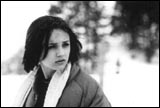 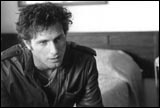 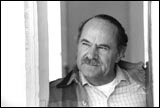
The Hi-Line Cast

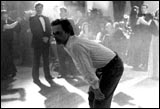 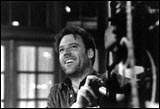 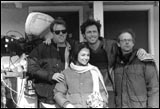
The Hi-Line Crew

More information is available on the Creative Light Worlwide website on The Hi-Line page.

Read the official Press Release.
See here for a listing of press on 'The Hi-Line'
|